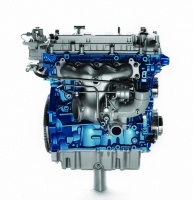
If that energy could be recovered, the efficiency of the engine would be significantly increased.
’A normal turbocharger takes some of this energy that would otherwise be wasted to the atmosphere, but not all of it,’ he explained. ’The turbocharger is designed for a steady-state operation, whereas the exhaust gases increase and decrease at the rate of the engine reciprocation. The idea is to oscillate the turbocharger’s variable geometry and synchronise it with the engine exhaust to get better energy recovery from the pulsating exhaust flow.’
It uses a fast actuated nozzle to follow the exhaust pulse, reducing the turbine inlet area periodically to increase exhaust-gas pressure.
The potential for increasing engine efficiency is substantial and even greater when coupled with advances in internal combustion engines.
’We are going to see ever smaller engines in cars as we move towards low-carbon vehicles,’ he said. ’These are going to be downsized engines, with a one-litre engine giving the same performance as a two-litre engine using current technology, or perhaps a five-litre engine could be reduced to 1.9 litres. But the key thing is the driver experience and response should be the same.’
Patents have already been applied for and Martinez-Botas has just received a significant grant from EPSRC/TSB to support a detailed feasibility study on a prototype. ’We believe the path for commercialisation of this technology will be through licensing it to an engine developer or a turbocharger developer, and they will then manufacture and implement the technology,’ he said. ’We’ve already carried out testing and simulations, but the key issue now is how to implement it in an engine.’
He is already talking to potential partners, but they have all come back with similar questions in relation to material limitations, reliability and fatigue failure. ’It has been recognised as a sound idea and the grant from EPSRC/TSB will provide the bridge funding for us to test its reliability in use,’ he said.











Water Sector Talent Exodus Could Cripple The Sector
Well let´s do a little experiment. My last (10.4.25) half-yearly water/waste water bill from Severn Trent was £98.29. How much does not-for-profit Dŵr...